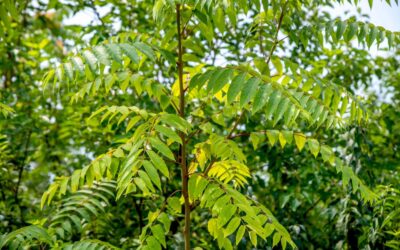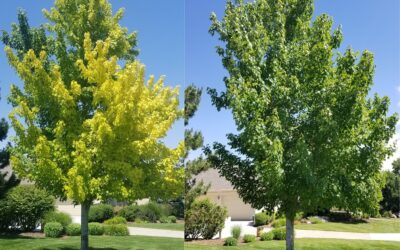If you’re looking for a shade tree that a Denver city forester once described as being tough as a junkyard dog, take a look at the chinkapin oak.
Sometimes spelled chinquapin, it’s a stately medium-size tree with a rounded canopy that’s native to the central midwestern US as far west as central Kansas and south into northeastern Mexico.
Characteristics
A medium growing tree, the chinkapin oak reaches about 40’ at maturity. Its rounded, slightly irregular canopy has glossy narrow dark green leaves with a rounded base. Part of the white oak family, the chinkapin’s elliptical leaves are 2 to 4 inches long and 1½ to 3 inches wide with 8 to 14 rounded or pointed, coarse teeth on each side. Its twigs are slender and stiff, and its trunk has grayish bark with shallow furrows and short, flaky ridges. The chinkapin flowers in early May and develops ½ inch acorns that ripen in September. A lower-growing dwarf variety is also planted as shrub or border tree.
Environment
Chinkapin oak grows best on deep, moderately alkaline, well drained soils, but adapts well to a variety of conditions and is drought tolerant. Avoid damp or highly alkaline soils. It needs full sun, so avoid planting it near taller trees and buildings. When planting seedlings in rows as a windbreak or screen, space them 8-12 feet apart and keep weeds away until the trees are well established, usually 3-4 years. Chinkapin oaks are robust, with few pests or diseases. They can be subject to common oak problems such as iron chlorosis and powdery mildew, but those can be managed easily with proper diagnosis and treatment.
Biological Importance
The chinkapin oak is known for its sweet thin-shelled acorns that have been enjoyed by humans and wildlife for centuries. They’re an excellent source of food for wildlife including squirrels, chipmunks, deer, wild turkey, and other birds. Browsing animals such as deer often feed on the tender leaves and shoots.
Oak trees attract a variety of insects that provide food for other animals as well without causing significant damage to the tree.
While not usually planted for timber, chinkapin logs resemble white oak and can be used for both construction and firewood.
Properly chosen and maintained trees are an important investment that can add considerable value to both residential and commercial property. Donovan Arborists offers planting, pruning, and shearing services for chinkapin oaks and other trees and shrubs as well as a complete landscape maintenance package for property in the Denver area.
We’re always happy to give free estimates to homeowners and property managers for any services they may need.



